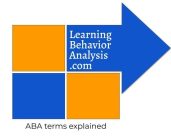C-9: Select a measurement system to obtain representative data given the dimensions of behavior and the logistics of observing and recording ©
Want this as a downloadable PDF? Click here!
Target Terms: Whole Interval Recording, Partial Interval Recording, Momentary Time Sampling, Planned Activity Check (PLACHECK)
Whole Interval Recording
Definition: An observation time that is divided into smaller series of brief time intervals where at the end of each interval, the observer records whether the target behavior occurred throughout the entire interval or not.
Example in a clinical context: A BCBA is collecting data on a child’s on task behavior in 10 second intervals. They only circle “yes” if on task behavior occurred in the interval if it occurred for the entire 10 seconds.
Example in a supervision/consultation context: A behavior analyst is consulting for a large company that produces medical technology. The company wants to increase work productivity. The behavior analyst targets on task behavior (e.g., attending to work assignments, not engaging in other non-work activities like checking phones) in one-minute intervals. If an employee engaged in on task behavior for the entire one-minute interval, the consultant records “yes.”
Why it matters: Whole interval recording is best used for measuring behaviors you want to see increase, since it provides a conservative rate of the behavior of interest. Whole interval recording tends to underestimate the rate of a behavior. Though not precise, it is useful when recording each occurrence of (a) behavior(s) is impractical.
Partial Interval Recording
Definition: An observation time that is divided into smaller series of brief time intervals where at the end of each interval, the observer records whether the target behavior occurred at any point during the interval.
Example in clinical context: A behavior analyst is conducting an observation on a client and is collecting partial interval data in five-minute intervals on the target behavior. The client engages in problem behavior two minutes into the interval and not again for the rest of the interval. The behavior analyst circles “yes,” because the target behavior occurred during part of the interval.
Example in supervision/consultation context: A behavior analyst is consulting for classroom where many of the staff members check their cell phones during work time. The behavior analyst observes the employees and collects partial interval data in 10-minute intervals. If an employee engages with their phone at any point during the 10-minute interval, the behavior analyst records that the target behavior did occur within that interval.
Why it matters: Partial interval data is best used for measuring behaviors that you want to see decrease, since it provides a conservative measure of the behavior of interest. Partial interval data tends to overestimate a behavior of interest. Though not precise, it is useful when recording each occurrence of (a) behavior(s) is impractical.
Momentary Time Sampling
Definition: An observation time that is divided into smaller series of brief time intervals where at the end of each interval, the observer records whether the target behavior occurred at the end of the interval only.
Example in clinical context: A behavior analyst is observing a client’s pacing behavior using momentary time sampling with an interval of 10 seconds. The behavior analyst indicates whether pacing behavior occurred only if the client was pacing at the very end of the 10 second intervals.
Example in supervision/consultation context: A teacher is receiving coaching on taking data on a particular student’s out-of-seat behavior while teaching the whole class. The consultant coaches the teacher to look at the specific student whenever the buzzer goes off (every 60 seconds) and immediately record whether the student was in her seat or out of her seat when the buzzer went off.
Why it matters: Momentary time sampling can overestimate or underestimate the rate of behavior. Since you do not continuously measure throughout the entire interval as you do with partial and whole interval, it’s smart to ensure that intervals are short enough to observe the target behavior frequently. Though not precise, it is useful when recording each occurrence of (a) behavior(s) is impractical.
Planned Activity Check (PLACHECK)
Definition: An observation time that is divided into smaller series of brief time intervals where at the end of each interval, the observer records whether the target behavior occurred at the end of the interval only in a group setting.
Example in clinical context: A behavioral consultant is collecting data on classroom of student’s on task behavior during their scheduled rotating activities using PLACHECK intervals of 30 seconds. At the end of the 30 second interval, the behavioral consultant observes if all the students in the classroom were in their assigned areas of the room. If not all students were, the behavioral consultant would indicate that the target behavior was not observed.
Example in a supervision/consultation context: A behavioral consultant is recording data on employee performance in 20-minute intervals. At the end of the 20-minute interval, the behavioral consultant looks up and observes if all employees are engaging in their assigned tasks (at their respective desks, oriented to computers, with work tasks on the screen). If all employees are engaging in their assigned tasks, the behavioral consultant records that the target behavior occurred during the interval.
Why it matters: PLACHECK allows the observer to collect data on groups as a whole.
